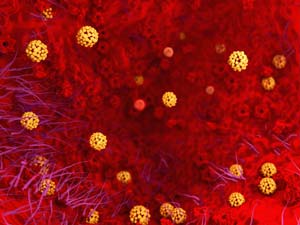Mar. 10, 2017 Research Highlight Biology
Switching sites for robust reproduction
The SARS virus uses an unusual protein processing strategy in infected cells, which may offer a vulnerability that can be exploited by new drugs
 Figure 1: Artist’s depiction of severe acute respiratory syndrome (SARS) viruses. © JUAN GARTNER/ Science Photo Library/ Getty
Figure 1: Artist’s depiction of severe acute respiratory syndrome (SARS) viruses. © JUAN GARTNER/ Science Photo Library/ Getty
Many viruses contain highly compacted genomes, in which many mature proteins are enzymatically processed from one or two longer ‘polyproteins’. An all-RIKEN team has identified an unusual mechanism regulating this process in the severe acute respiratory syndrome (SARS) virus, which could offer a useful target for new therapies1.
A serious form of pneumonia, SARS (Fig. 1) made headlines 15 years ago when it spread rapidly around the world. While the outbreak was quickly contained, the threat of future ones looms.
The SARS virus produces two overlapping polyproteins, which contain the enzyme 3C-like protease (3CLpro) in the overlapping region. This enzyme carves up the polyprotein at 11 different sites, liberating itself and numerous other viral proteins. 3CLpro relies on a particular pattern of amino acids to know exactly where to cut; specifically, it recognizes leucine residues situated two amino acids from the cut site.
After analyzing the enzyme’s structure, a team including Shigeyuki Yokoyama of the RIKEN Structural Biology Laboratory has discovered that the real picture is more complicated than this.
 Figure 2: Shigeyuki Yokoyama and his team have found an unusual protein processing strategy used by the SARS virus during reproduction, which may offer a good drug target. © 2017 RIKEN
Figure 2: Shigeyuki Yokoyama and his team have found an unusual protein processing strategy used by the SARS virus during reproduction, which may offer a good drug target. © 2017 RIKEN
The team investigated how 3CLpro enzymatically liberates one of its two ends (known as the C terminus) from the polyprotein. They were intrigued to notice that target recognition at this site entails interaction with different amino acids at other sites in the polyprotein. Rather than relying on leucine residue recognition, C-terminal cleavage involves interaction with a pair of phenylalanine residues located at fixed positions on either side of the cut site.
The team discovered that the enzyme’s interaction with one of the two phenylalanine residues triggers structural changes in its binding site, which then enable it to interact with the second residue. Hence, cleavage requires both phenylalanines to be present.
“The recognition of the phenylalanine at this second site was undetectable by analyses of the consensus amino acid sequence of the enzyme’s substrate peptides,” explains Yokoyama. “Our finding was possible by combining x-ray crystallography and mechanistic biochemical assays.”
Yokoyama conjectures that this alternative recognition mechanism is critical to the enzyme’s function. If the fully liberated enzyme molecules contained the standard leucine-based 3CLpro recognition site, these sites could potentially bind and inhibit the enzyme, preventing further viral maturation. By employing this different, two-site recognition element at the C-terminal end of 3CLpro, the virus prevents autoinhibition and ensures efficient polyprotein processing.
Interfering with this process could thwart viral reproduction. “One could develop drugs that target the excision of this protease from the polyprotein,” says Yokoyama. “The mechanism of recognizing this C-terminal processing site, which is unique to this protease, could be an especially good candidate drug target.”
Related contents
References
- 1. Muramatsu, T., Takemoto, C., Kim, Y.-T., Wang, H., Nishii, W., Terada, T., Shirouzu, M. & Yokoyama, S. SARS-CoV 3CL protease cleaves its C-terminal autoprocessing site by novel subsite cooperativity. Proceedings of the National Academy of Sciences USA 113, 12997–13002 (2016). doi: 10.1073/pnas.1601327113
